#aerrhea
Text
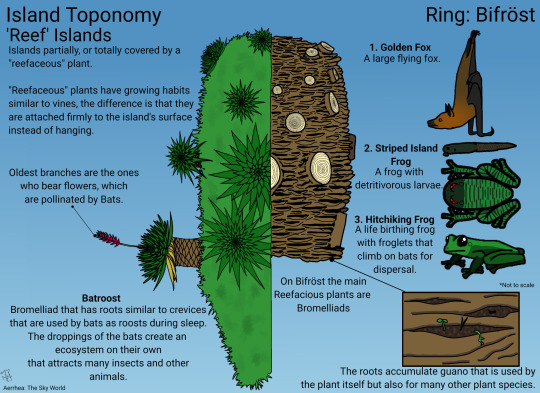
Island Toponomy
Ring: Bifröst
'Reef' Islands
'Reef' Islands are islands totally or mostly covered by "Reefaceous" or Reef-building plants, who here in Bifröst are Bromeliads.
These plants tend to be the foundation for other plants, gathering substrate for later species such as grasses, trees, etc. But also literal footing for animals not only moving from island to island but as in roosts or places to hide in. Thus they are called reefaceous/reef-builders, due to their ability to house in an ecosystem on their own within their roots.
Not all (in fact only a few) islands are completely reefaceous in nature as these kinds of plants tend to come later in the ecological succession of islands, competing fiercely with the wind-dispersed vines.
Individual Species Description
Batroost Creparophora insulobnubens (Crevice-Bearing Island-Coverer)
This plant is the type genus for not only its family but for Reef-building plants from Bifröst in general.
This plant starts out as a small, vividly colored, sweet fruit that is then consumed by animals such as bats, monkeys, goats and humans. Then carried within their stomachs to other islands where the small, hardy seeds contained within the droppings will hopefully get a strong footing to start growing many branches during its life. That is, in between the roots of other plants, including other Batroosts.
The plant itself starts to grow faster than trees but slower than the quick-growing vines, but fast enough to get a good grip on the surface of the island. Then, growing slowly over the years they spread across the island with their 'cracked' roots, collecting detritus and doing their namesake -serving as the roosts for bats.
Bats are definitely the most notorious of the daily users of this plant, using the roots to hang themselves upside down while covered by the many vines that grow over, and among the roots of the Batroost.
This is the case for the Golden Fox (Pteropus vulgaris Meaning "Common Foot Wing") which is a large, frugivorous bat from the same genus as the Flying Foxes from Earth, hence the "fox" in their name. The Golden Fox is a common (though not the only) dweller and user of these plants as roost. They not only benefits from the plant but the Batroosts also benefits from the bats, not only from the aforementioned nutrients found in their droppings (guano) but also to spread the seeds of the plant, as the fruit is a favorite meal of the bat.
However they are not the only animals to use this bromeliad, in fact many animals live their whole lives -or at least part of it- among the twisting crevices of the plant.
The Striped Island Frog (Vermigyrinus spp meaning "Worm Tadpole") is such an animal that lives part of its life among the roots of the Batroost. Although the adults live close by, hunting for insects and small vertebrates among the vines and trees, the larvae have a very specific niche. They don't necessarily need water to survive because they live in the concentrations of guano and decaying matter that accumulates in the crevices of the roots, a niche that is somewhat lacking in Aerrhea for one reason: There are no worms in this world. For whatever reason there are not annelids in Aerrhea (or at least in Bifröst) to live in and eat the humus of the shallow soil of islands, thus these frogs took this golden opportunity and exploited it. The Crevice micro-ecosystem is a well protected one and not explored by many as it is covered by thousands of vines, blocking the view of large predators and also their passage, offering a calm existence in these "pockets of nutrients" as far as "calm" can go in a constantly moving habitat. Which is also another pro for such a lifestyle as this is both a relatively competition-free ecosystem with many nutrients to consume.
The long tadpole can live for two weeks on their personal "terrariums" before metamorphosing into adults, climbing out of the roots' area and never returning again, at least that is the case for the males as the females after copulation (this species has internal fertilization) return to the crevices to lay 1-3 eggs -depending on the size of the crack and available detritus-, each on a different crevice to avoid competition among the larva and then leave them on their own until they grow into frogs and the cycle repeats again.
An example of an animal that lives its "whole" life among the nooks and crannies of the dark, understory is the Hitchhiking Frog (Viatoribus spp meaning "Passenger") who gets its name from its habits early in life. This tiny little frog also has internal fertilization, but instead of laying eggs they give birth to developed froglets whose voyage starts not long after being brought into this world. The mother frog, who lives by the crevices eating small invertebrates such as ants, climb upon roosting bats and give birth to their small versions of themselves, who using two opposing fingers grab onto the fur of their hosts and wait until they set flight again. This strategy is used due to the small size and vulnerability of these frogs, who use the larger bats as means of dispersing into other islands, giving a higher genetic diversity to these small ingenuous frogs.
#aerrhea#my art#worldbuilding#art#illustration#spec bio#speculative biology#spec evo#speculative evolution#speculative zoology#fantasy#speculative ecology#speculative worldbuilding#speculative botany
37 notes
·
View notes
Text
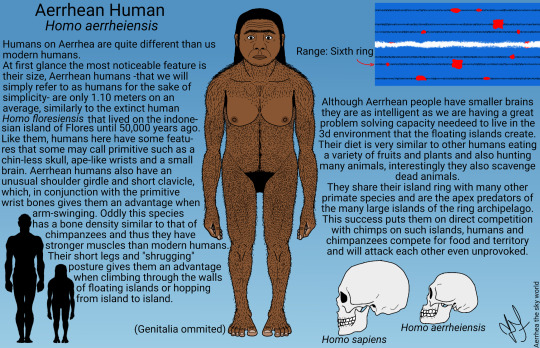
The humans from my setting, Aerrhea, for more info on Aerrhea check the link:
Btw the floating spino is no longer canon sadly, it doesnt fit the rules i have set for the world.
#art#illustration#worldbuilding#creature art#digital art#fantasy art#fantasy#spec bio#aerrhea#aether#human#spec evo#speculative biology#speculative zoology#original species#speculative evolution
19 notes
·
View notes
Text
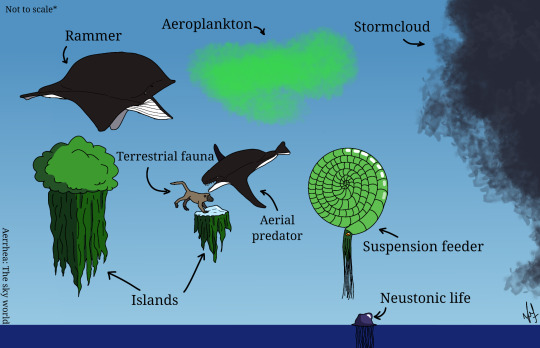
Diagram showing the different parts of the Aerial ecosystem on Aerrhea.
More on that here: https://aerrhea.miraheze.org/wiki/Ecosystems
For more about Aerrhea itself check here:
#worldbuilding#aerrhea#art#illustration#spec bio#speculative biology#speculative zoology#fantasy world#fantasy creatures#fantasy art#fantasy
75 notes
·
View notes
Text
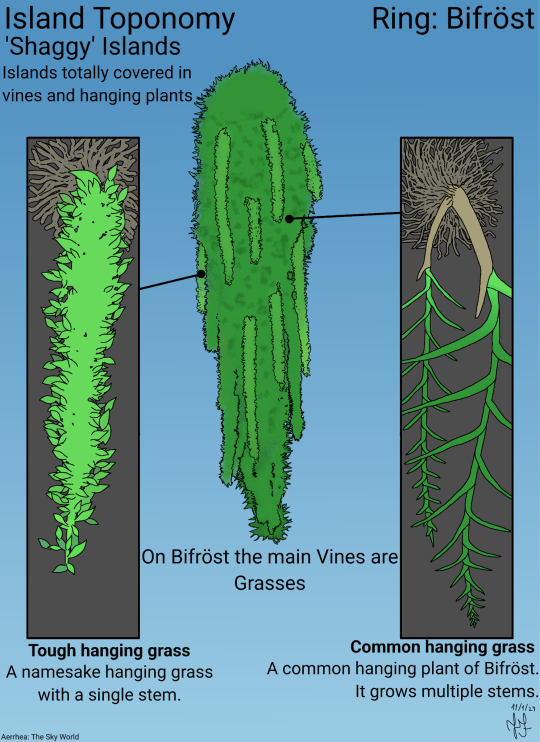
Had this one for a while now, planned to post it here once the full wiki page was done but that will not be for now. More under the cut.
Island Toponomy
Ring: Bifröst
'Shaggy' Islands
Shaggy islands are islands totally covered in vines and hanging plants, giving them the appearance of a fuzzy island from a distance. Here in the first ring of the world, Bifröst, the main vines are grasses. These islands are commonly used by bats and small animals as resting spots since the viny plants can be easily woven into nests.
Vines are a crucial part of island-to-island movement by both animals and humans, their abundance works as a holding spot if one is to fall and their long tendrils can be used as security belts. As expected they derive most of their nutrition from sunlight, but due to their position on the side of islands they dont get much of the nutrients that accumulate on their tops, instead most vines employ carnivory by means of sundew-like flowers or cup-shaped pitcher-plant like leaves.
Individual species description.
Common hanging grass Vulgarivinea multicaulis (multiple stemmed common vine)
This grass is very common all across Bifröst, hence its name. It has the habit of growing a sprawling system of roots and many stems, to maximize sunlight intake. For other nutrients it generally grows many sundew-like flowers(not depicted) to attract and catch insects using a sticky, sweet substance that emanates from the flowers. Some humans call these plants something akin to "sweet vines" due to such flowers being harmless to humans and thus commonly eaten as delicacy.
Tough hanging grass Circumlatro durus (hard bark)
A long grass with no more than one stem, this plant is very strong and can singlehandedly hold animals the size of gorillas and even higher. Thus sought out by animals who do not want to fall into the depths below. Humans have another use for it though, beneath the foliage of other vines that cover the base of its stem lies a very resistant bark used for many things such as ropes. For extra nutrient intake it implies a pitcher plant-like strategy where a large cup-like leaf secretes a sweet substance that attracts small mammals who 'sit' on the leaf to drink its sweet liquid whose nectar also has laxative substances. This way the animal will defecate immediately after licking the substance, providing the plant with nutrients.
#worldbuilding#art#illustration#spec bio#speculative biology#speculative evolution#spec evo#my art#plant spec#fantasy world#fantasy art#fantasy#fantasy worldbuilding#aerrhea
36 notes
·
View notes
Text

Skywhale, want feedback on its design
#worldbuilding#art#illustration#spec bio#speculative biology#speculative zoology#spec evo#speculative evolution#aerrhea
21 notes
·
View notes
Text

Island Toponomy
Ring: Bifröst
Meadows
Meadows are biomes within islands that are mostly covered by grass-like plants, forming a carpet of plant life that can cover many meters or even kilometers.
Here on Bifröst meadows are actually covered by grasses. You may be familiar with the hanging grasses that cling to the sides of all islands, but these are more familiar to the Earthen grasses.
However one major difference from the grass you may see in your backyard is that these grasses have an unique trait. Their roots are sponge-like, once a seed lands into a suitable place for growth it starts growing, spreading and cloning itself -for many times a single organism can be a whole biome- using its spongy mass of roots that clings to the rock surface tightly. This mass of spongy roots traps both water and nutrients, forming its own soil like many other plants do on Aerrhea. The ground in meadows is thus moist and cold to the touch.
This biome is preferred by many animals, namely grazers such as goats and some species of monkey, humans that follow such animals around or even build societies over this kind of terrain and smaller animals such as snakes and frogs that find shelter in the tall foliage.
#aerrhea#my art#my post#my ocs#art#illustration#worldbuilding#spec bio#speculative biology#spec evo#speculative evolution#culture#culturebuilding
7 notes
·
View notes
Text

Specposium's Spectember day 3: Atavism
I was very undecided today so i went with concept art for Aerrhea, specifically aerial whale concept art.
Atavism is when a trait long lost in an animal group reappears, for example whale hindlimbs, exactly what is happening here, the back fins were useful for these whales because they could be attachment points for the patagia, creating more wing surface area.
Aerial whales are generally called airheads as instead of melons for echolocation they have aether sacks used for floating, the aether sacks run down into the tail. They hunt a variety of prey, principally fish and cephalopods.
#specposium#spectember 2023#spectember#aerrhea#worldbuilding#art#illustration#spec bio#speculative biology#spec evo#speculative evolution#speculative zoology#whale#creature concept#concept art
37 notes
·
View notes
Text
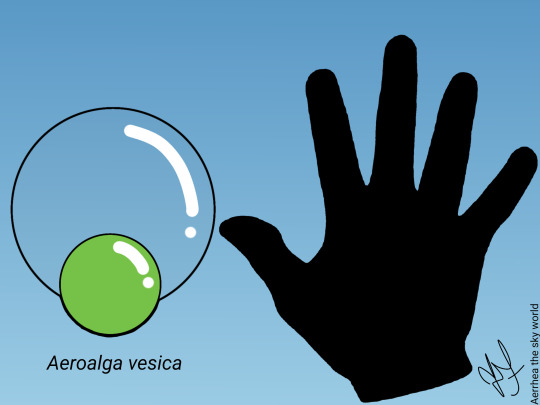
Specposium's Spectember day 28: Spec at the cell level
Speculative unicelular organisms are kind of tricky because there is a high chance that your spec microbe is a thing in real life already.
Here we have a gigantic algae that creates a membrane that is filled with aether, making it float. The membrane is translucent so sunlight can reach the algae and so it can photosynthesize. A common aerophytoplanktonic organism in the skies of Aerrhea.
#aerrhea#specposium#spectember#spectember 2023#worldbuilding#illustration#art#spec bio#speculative biology#spec evo#speculative evolution#speculative zoology#fantasy world#fantasy
26 notes
·
View notes
Text
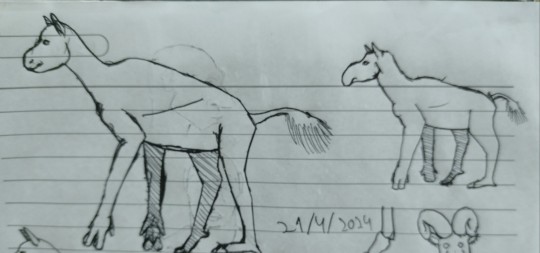
Hey! If it isnt the artist with dubious content posting sketches of dubious goats of dubious artistic quality!
#aerrhea#worldbuilding#art#illustration#spec bio#speculative biology#spec evo#speculative evolution#speculative zoology#my art#fantasy
7 notes
·
View notes
Text
Cosmology of Aerrhea Part III: The Aether
There is a magical element unique to Aerrhea called Aether.

Aether is a magic element unique to Aerrhea, it has the atomic number of 126 and atomic mass of 310, it is as light as hydrogen or helium, somewhere in between. It has two documented forms, a solid and a gasous form.
The solid form(Aethereal rocks) cannot be eroded by normal water or by the wind, but it can, and will be eroded by collisions with other islands forming what we call Detritus and Fragments. Aetheral rocks are quite similar to volcanic rocks such as obsidian but are not used as blades or other tools by the humans due to its floating state.

Gasous Aether is found in the atmosphere and inside animals, most commonly in bladders similar to air-sacs in birds on Earth, but in Aerrhea are filled with Aether for the same purpose, ascending or descending into the air or water.
Archipelagos are many islands that circle around the center of the world and every Archipelago is tilted, that means that archipelagos have one side higher than the other which can be seen as "seasons". Seasons work like so: Due to the constant movement of the islands, going up and down from time to time and carrying fauna and flora with them. There are two main seasons, one called The High Season and the other being called The Low Season.
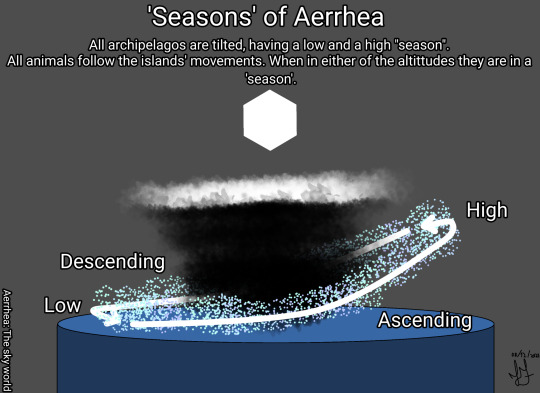
The High Season is when a portion of the islands are in the highest height they can be at, this season is defined by the low temperatures caused by high altittudes and the low quantity of nutrients circling around. During this season plant growth is slow. The Low Season is the complete opposite, islands here are very close to the sea level and so the climate is hot and nutrients are circling around frequently because of piscivorous animals hunting sea food and depositing their guano in the islands, providing important nutrients to the plants who use of this season to grow. Descending and Acending are intermediary stages in between the High and the Low seasons when the islands are going down or up respectively.
#aerrhea#my art#worldbuilding#art#illustration#fantasy#fantasy worldbuilding#fantasy world#cosmology#magic#low fantasy
12 notes
·
View notes
Text
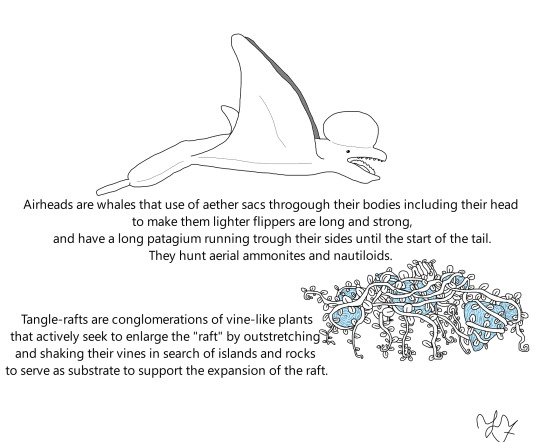
Some concept art for creatures from Aerrhea, it wouldn't be a floating islands world without flying whales!
#art#illustration#worldbuilding#fantasy art#creature art#magic#aerrhea#digital art#aether#whale#fantasy creature#fantasy#fantasy world
1 note
·
View note
Text
Cosmology of Aerrhea part II
The Sun
The Sun itself is a bright icosahedron that sits in the center of the world and is some thousands of miles away of the surface of the cylinder, the sun extinguishes itself every day and then is "reborn" again, forming the day and night cycle. The process of extinction starts at 17:30 Pm and ends at 18:00 pm when the night begins, thus dusk lasts for half an hour. The rebirth starts at 04:00 Am and ends at 05:00 Am when the day truly begins, thus dawn lasts for one hour. These processes happen by the gradual reduction of both size, faces and luminosity of the sun, the opposite is true for the process of rebirth.
The sun has 5 phases during its rebirth: it starts as a tetrahedron, it then gains two more faces, becoming a cube, then it gains two more again to become a octahedron.In its penultimate stage it gains four more faces becoming a dodecahedron and in its most luminous, large and final stage it gains eight more faces, becoming a twenty-faced icosahedron. During the extinction it passes trhough the same process, but instead of gaining faces it loses them.
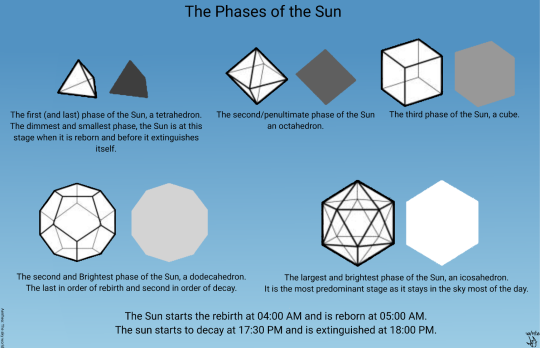
Diagram showing the different stages of the Sun.
The Moons and the Night
During the night the world is lit by one of the two moons that circle around the cylinder. Muninn (the smaller moon) is brighter than Huginn(the larger one), thus the night is either bright or relatively darker depending on the moon that is in the sky. There is also the "moonless nights" that happens every two days as the next moon in the sky didn't get up in time so there is a night cycle that works as: Müninn>Moonless>Hüginn>Moonless>Müninn... Moonless nights are not completely dark as Airglow and the stars illuminate the nightsky in the absence of the moons. The moons are named after Huginn and Muninn two crows from Norse Mythology that flew daily over the world.
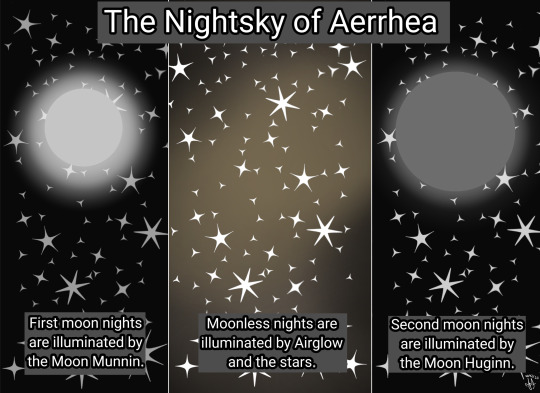
The cycle of Nights.
The stars of Aerrhea are not stars as we know them from astronomy but as star polygons from geometry or from more popularly, children's drawings. The stars in the sky can have 3, 4, 5, 6 and 8 "arms". The more arms a star has the rarer, larger and brighter it is.
The types of Stars of Aerrhea.
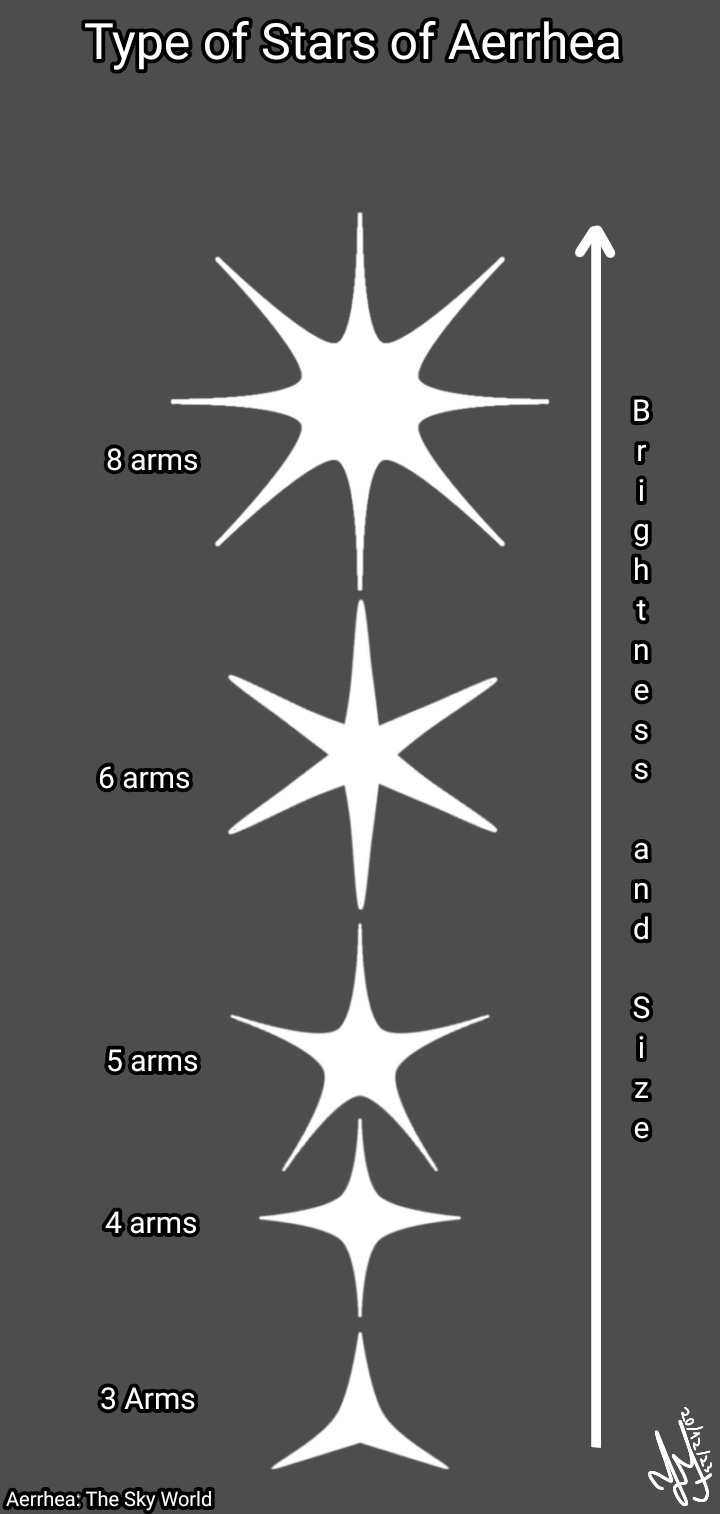
#worldbuilding#art#illustration#fantasy worldbuilding#fantasy world#fantasy art#fantasy#cosmology#my writing#my art
17 notes
·
View notes
Text
Cosmology of Aerrhea Part I
The cosmology of Aerrhea is very different from that of Earth, the world, the sun and the very laws of the universe are sometimes wildly different from that of our own universe.
The World
The world of Aerrhea is a cylindrical shaped one opposed to a globe like Earth. The cylinder is an oceanic world, it has no landmasses, only a deep ocean whith a bottom that is basically bedrock, which is very similar to the bottom of our own oceans by having hydrothermal vents spewing minerals into the water. The world spins around its own axis with no axial tilt, this movement makes the islands get arranged into island rings. Six of these island rings exist, each one with its endemic fauna and flora. The rotation of the world combined with the low pressure zone created by the sun also creates a central, unending storm. One notable fact is that if (somehow) something reaches the border of the cylinder it will not see it or fall out of the world, in fact it will not even realize that it has reached the border as it will wander into the exact opposite of that border, the other side of the world.
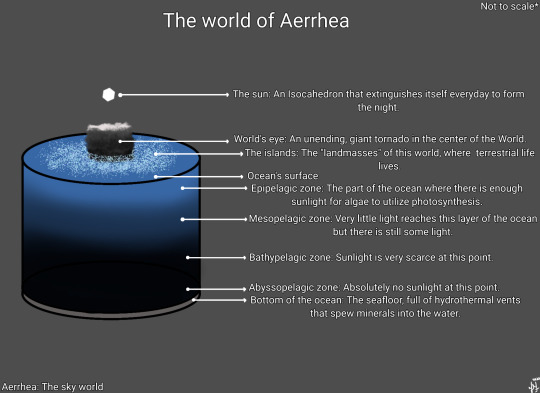
Diagram showing the main aspects of the world
Due to the Sun's size and luminosity being far lesser than that of our own Sun its light starts to fade away because of the gases in the atmosphere or the water, creating colder and darker regions in the world that are further away from the Sun.
In the ocean there is the Epipelagic Zone that is the highest layer of the ocean, it is highly productive because of the sunlight that reaches this area, making the process of photosyntesis possible by autotrophs.
The second layer is the Mesopelagic Zone where only 1% of the light given by the sun actually reaches this layer until it fades away, photosynthesis is already inpossible here but yet life is abundant as the animals here feed on the marine snow that falls from the epipelagic zone and from the sky.
The Bathypelagic Zone is completely devoid of light and very little life resides here, the ones that do eat marine snow too.
Finally, the deepest part of the ocean is called the Abyssopelagic Zone where surprisingly, there is an abundance of life due to the marine snow that is deposited in the bottom of the ocean who serves as food for "grazing" animals in the seafloor. Marine snow is not the only primary resource here though, hydrothermal vents are very common here and they are the base of the other 50% of the ecosystems in this oceanic layer. The hydrothermal vents spew tons of minerals in the water that are used by chemosynthetic bacteria to produce energy in a similar way to plants and other autotrophs, these bacteria are the primary producers of this ecosystem and so they serve as food for many other organisms.
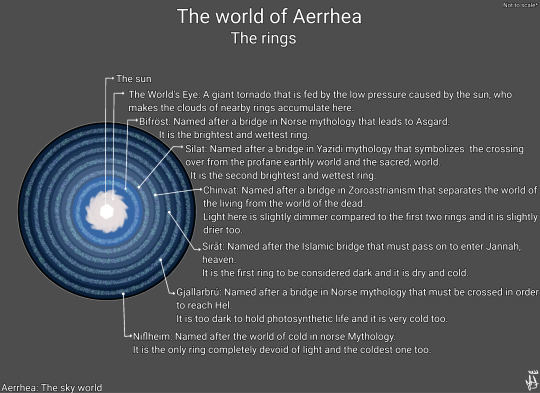
Diagram showing the rings of the world and some of their characteristics.
A Similar thing happens in the surface.As mentioned above the sunlight gets dimmer the further away you get from it due to gases in the atmosphere that scatter the light, making the furthest archipelago very cold and dark. Here are some traits owned by each ring:
Archipelagos:
Bifröst is the first ring of the world, named after the Bifröst bridge from Norse mythology that is a burning rainbow that connects Midgard(earth) to Asgard(the realm of the gods). It was named in such way because of how this ring(technically a circle) is the brightest and wettest ring as it is the closest to the center of the world and thus closer to the sun. It is also home to the World's eyes.
The second ring is called Silat, named after the Silat bridge from Yazidi religion that simbolizes the connection and crossing over from the profane earthly world and the sacred, esoteric world. The ring is named like this because it is the second ring of the world and so it connects the hot, wet and luminous center to the colder, drier and darker rings.
The third ring is called Chinvat, named after the Chinvat bridge in Zoroastrianism that separates the world of the living from the world of the dead. Named so because as the third ring it is the midpoint between the lighter and darker rings of the world, similarly to the bridge's role.
The fourth ring is called Sirāt, named after the as-Sirāt bridge from Islamism that is the bridge where every person will pass trough during the judgement day, the damned falling from it onto the hellfire and the saved going to paradise. This ring's naming is similar in reason to the Chinvat ring.
The fifth ring is also named after a Nordic bridge, Gjallarbrú which is a bridge that leads to Hel, the underworld in Norse paganism. Such name is in reference to this ring's proximity with the last ring of the world that is cold and dark. Gjallarbrú is one of the coldest and darkest rings of the world, here photosyntesis is unviable and so the trophic chain is ignited not by plants but by bacteria.
Finally, the last ring of the world, Niflheim. Named after the world of primordial ice from Norse culture, which is fitting for this ring due to its intensely cold temperature as it is the furthest away from the sun. Just like Gjallarbrú it is too dark for photosyntesis and curiously, the native life is, actually native. The organisms that live here are not Earthen organisms but rather life originary from Aerrhea.
#worldbuilding#art#illustration#fantasy world#fantasy art#fantasy#fantasy maps#fantasy worldbuilding#cosmology#my art#my post#my writing
17 notes
·
View notes